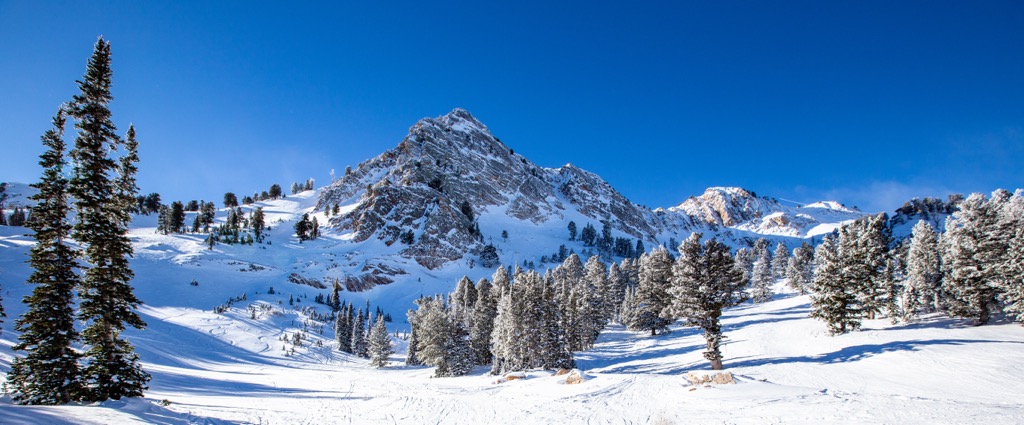Get PeakVisor App
Sign In
Search by GPS coordinates
- Latitude
- ° ' ''
- Longitude
- ° ' ''
- Units of Length
- Temperature

Yes
Cancel
Share ×

Scan the QR code and open PeakVisor on your phone
❤ Wishlist ×
Choose
Delete
Powder Mountain ski resort (known as “PowMow” to locals) encompasses a large area of the Wasatch Mountains in northern Utah. The ski area occupies a broad bowl, dropping from the ridgeline to the basin below. The resort comprises 8,464 total skiable acres (34.25 km2) and 2,800 lift-serviced acres (11 km2). Here lies an important distinction, as one of the elements that sets Powder Mountain apart is the focus on accessing terrain through snowcats, snowmobiles, and alpine touring. If counting all the skiable terrain - lift-accessible and non-lift-accessible - Powder Mountain would be the largest ski resort in North America. As resorts typically only enumerate lift-accessible terrain, this accolade is usually still granted to Whistler Blackcomb. Like all Utah resorts, Powder Mountain’s other most notable feature is the sizable accumulation of coveted “champagne” powder snow that it accumulates yearly, often dubbed the “Greatest Snow on Earth.”
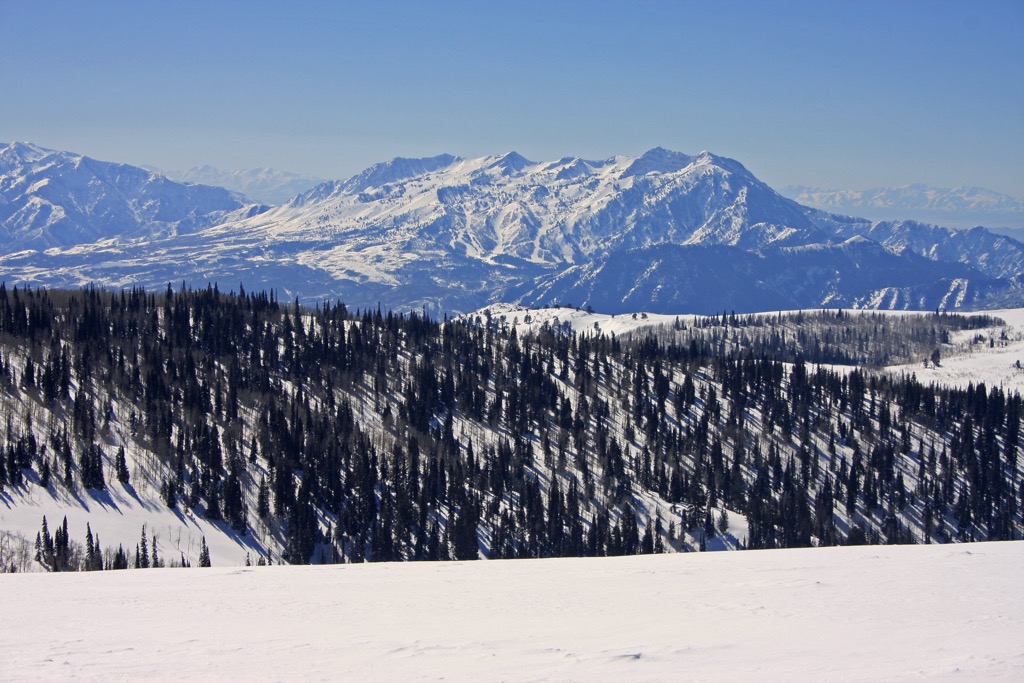
Powder Mountain sits in the northern reaches of the Wasatch Range, a north-south oriented sub-range of the Rocky Mountains. Like many resorts in the western U.S., the ski area operates on a lease with the land management entity, the Uinta-Wasatch-Cache National Forest. The area’s highest point, James Peak, sits at 9,422 ft (2,872 m), giving the resort 2,522 ft (769 m) of skiable vertical. Its boundaries fall within Cache and Weber Counties; the nearest town is Eden. The nearest airport is Salt Lake City International Airport, an hour's drive from the resort village. The closest major city is Ogden.
Interestingly, Powder Mountain’s parking area and village are nestled on a ridgeline near the top of the resort. To reach this area, visitors must drive up Hwy 158, an infamously steep and treacherous road (with a consistent grade of 14%, one of the steepest roads in the US). The route can make mountain access tricky, especially in the throes of winter’s wrath.
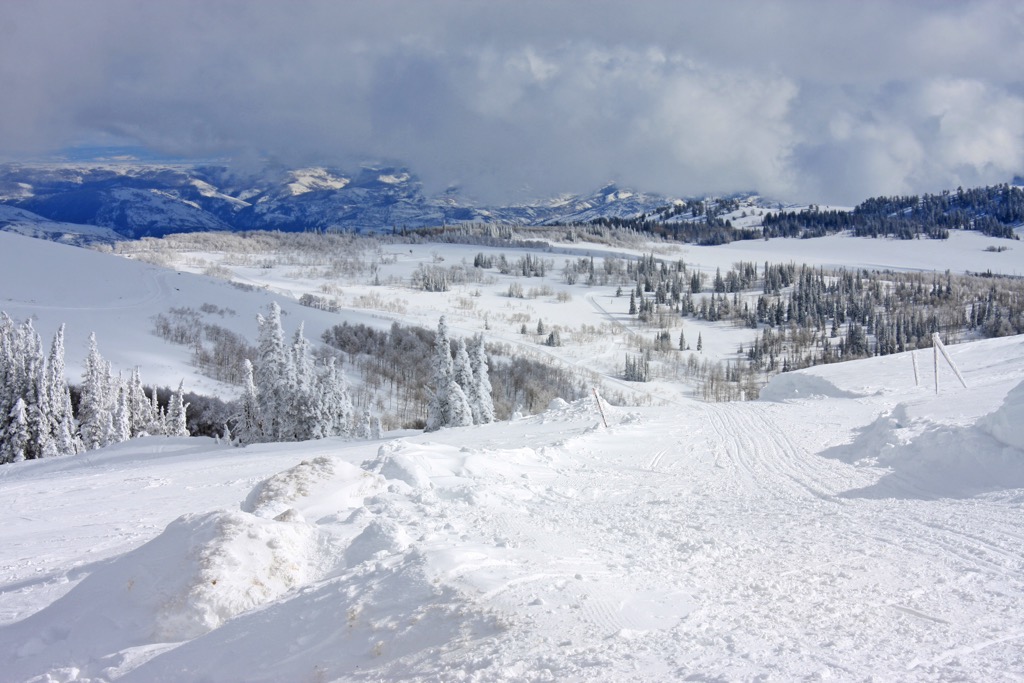
Many people associate Utah with nonstop powder snow, but the climate is technically a desert, and the seasons vary. Usually, snow begins to fall in late October or early November. Resorts in Utah typically open around Thanksgiving (the third week in November), and the ski season runs until around the third week in April. Closing day at most Utah resorts is around April 20th.
Statistically, the coldest month in the Wasatch mountains is January, and the snowiest is February. One of the primary factors determining whether Utah will have a good snow year is ENSO (the El Niño Southern Oscillation). I’ll talk more about that in a second.
Notably, Powder Mountain sits much further north than the majority of the resorts in Utah. Powder Mountain has its own microclimate to some extent and will often get buried while other resorts get skunked, or vice-versa. It also sits considerably lower than other resorts in Utah - compare it to Snowbird, with a base elevation of 8,100 feet (2,469 m) and a peak elevation (at Hidden Peak) of 11,000 ft (3,353 m).
These variables produce a climate around Powder Mountain that is much more variable than other places in Utah. While many of the higher resorts around Salt Lake City have consistent snowfall from January through March, Powder Mountain may experience various weather conditions on a day-to-day basis. The mountain is often foggy and socked in, and snowfall is sometimes wetter than in other Utah resorts. High winds are not uncommon. But, just as often, the conditions will line up, and Powder Mountain earns its name. When it snows here, it snows a lot.
The main driver for how a Utah winter will turn out is ENSO. Without getting too technical, ENSO is defined by sea surface temperatures around the equator.
Cooler water produces La Niña conditions, often hit or miss for Utah. La Niña years can be outstanding, such as 2022-2023, 2016-2017, and 2010-2011. But just as often, La Niña results in low snow totals in Utah. On the other hand, warmer than average ocean temps around the equator produce El Niño conditions, which often means excellent snowfall for Utah and the entire southern tier of continental North America (namely California, Utah, Colorado, Arizona, and New Mexico).
So what does this all translate to? For a resort like Powder Mountain, it can be the difference between six or seven hundred inches of snow during good years to just a couple hundred during bad years.
Overall, the mountain averages 500” (1,270 cm) of snowfall per year. “Average” years seldom happen, though. As I mentioned, Powder Mountain’s weather is variable. Good years are great, but bad years can be awful. However, when Powder Mountain lives up to its name, there is no place like it.
Snow in Utah tends to fall at a ratio of 14:1, meaning one inch of water produces 12 inches of snow. This ratio is a bit of a magic number, as it creates the coveted champagne powder Utah is known for. Utah snow is a little heavier than in other places like Montana and Colorado. But it skis fast, is light enough to be playful and soft, and falls deep. Storms at Powder Mountain commonly produce more than 24” (61 cm) of snow overnight.
On a month-to-month basis, Powder Mountain is relatively consistent. February is usually the most significant snow month here, but not by much. December, January, and March all typically have good storm cycles. March tends to have the broadest range of conditions - sunny “bluebird” powder days are interspersed with warm days of corn skiing.
Powder Mountain can be tricky to navigate without a map. The confusion starts when you arrive at the resort and find yourself at the top of the mountain.
In a nutshell, here’s the essential information to keep from getting lost. However, neither the visual guide (map) nor this verbal guide will truly prepare you for the resort - you’ll just have to spend a couple of days (or seasons) exploring the vast expanse of terrain.
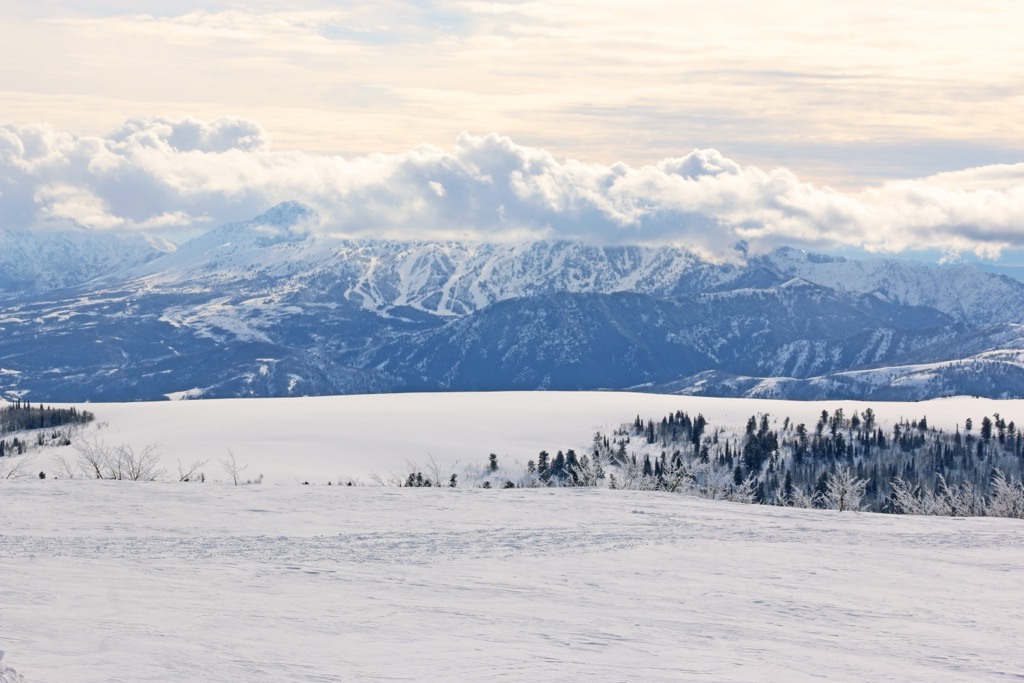
Powder Mountain consists of a comprehensive system of drainages and canyons descending from a central ridgeline. There are many high points along this ridge, but few are named. At the center of it all is Hidden Lake Lodge, the tallest lift-accessible point at the resort, which sits at 8,900 ft (2,713 m).
Looking left from Hidden Lake Lodge, you can see that the mountain is mainly arranged on the slopes of a broad bowl that faces roughly northeast. The bowl, subdivided by ridges into a series of parallel-running box canyons, constitutes the “front side” of the mountain.
Behind the front side, you’ll find a lot of smaller, shorter bowls that are also in bounds. To say the “back side” of the mountain doesn’t make much sense at Powder Mountain because each bowl on the back side technically has its own aspect.
Sundown, Powder Country, and Woody’s World are lookers right of Hidden Lake Lodge and face southwest. Lefty’s Canyon is located to the looker’s left and drops off the back side of the main ridge, featuring a western aspect. Mary’s Bowl sits next to Lefty’s Canyon and faces roughly south.
Moving from left to right on the main face of the resort, the first thing you’ll see on the map of Powder Mountain is Coyabe Canyon. This canyon is part of the mountain’s non-lift-accessible terrain. It’s a very steep box canyon and is forested on both sides.
To the right, you’ll notice a tall ridge that separates Coyabe Canyon from an unnamed drainage. This drainage is one of the main routes down to the bottom of Paradise Lift from Hidden Lake Lodge. The bottom of the drainage is a mellow slope. However, to the right of this is one of Powder Mountain’s most distinctive features, the rocky ridge hosting the Paradise Lift.
Above this long ridge is a broad, forested slope that varies in steepness. Continuing to the looker’s right, another nameless drainage leads downhill on the right side of the Paradise Lift ridge to the bottom of Timberline Lift. This short canyon is very steep on both sides. The left-hand side is the Paradise Lift ridge, and the right-hand side is called Lightning Ridge.
Lightning Ridge is another steep, rocky, cliffy area inaccessible by lift. Its left side runs downhill to Timberline Lift, and its right side runs into another drainage. This left side is dominated by expert-level terrain. These slopes are very steep and feature a mix of forested and open pitches. They are also part of the mountain’s non-lift accessible terrain, and you’ll have to take a cat ride (or hike, if you prefer) to ski them.
Just above the base of Timberline Lift and to the left of Lightning Ridge, you’ll find Timberline Lodge and Sundown Lodge. These two lodges comprise a separate base area that services Sundown Lift, as well as Powder Country and Woody’s World, two named slopes full of expert-level terrain.
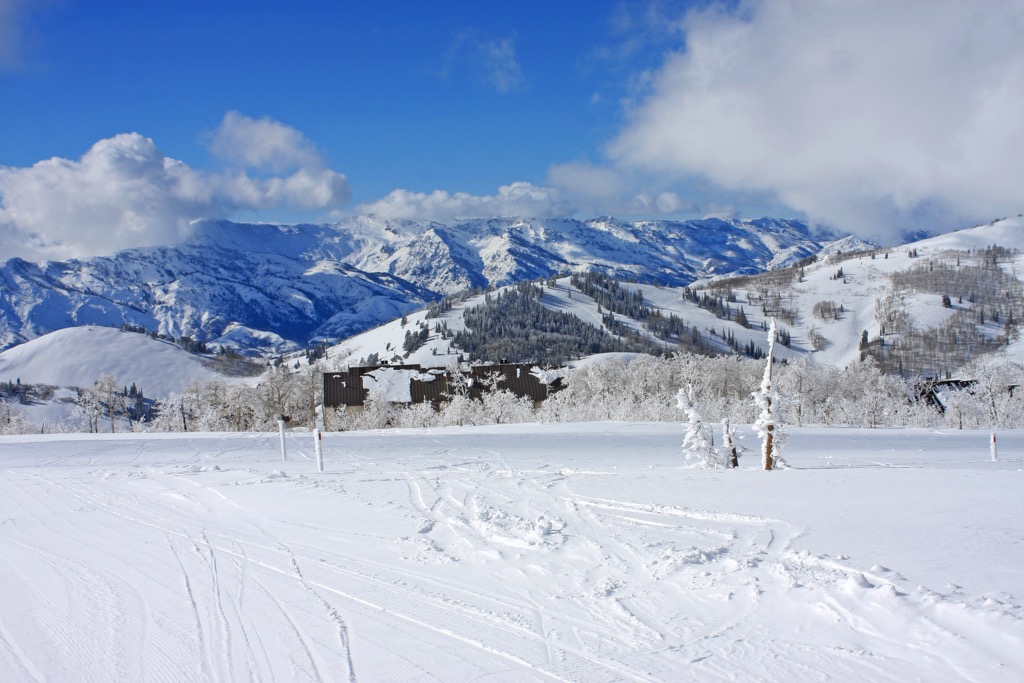
Sundown Lift provides direct access to Powder Country. It’s a short pitch of steep, forested terrain on the slopes of Sundown Peak (8,600 ft, 2621 m) and Baldy Peak (8,477 ft, 2,584 m), perfect for scoring powder turns after big storms.
Woody’s World is an exciting area because it’s technically lift-accessible but doesn’t have a dedicated lift servicing it. The easiest way to ski it is to start at Hidden Lake Lodge and ski west, down toward the road. But once you’re on the road, there’s no chairlift to return. Luckily, the resort runs a dedicated shuttle that picks people up from the road at the bottom of Woody’s World and Powder Country.
The other way to head downhill from Hidden Lake Lodge is straight south into Lefty’s Canyon. This canyon is split into halves, with one half accessible by Village Lift and the other only accessible by touring. The lift-accessible side of Lefty’s is a very relaxed area of the mountain. It’s forested with sparse aspens and is a prime spot for beginners and intermediates to begin pushing themselves and skiing powder.
You'll see a ridge at the top of Lefty’s Canyon, where the Summit Village sits. This ridge separates Lefty’s Canyon from Mary’s Bowl. Mary’s Bowl is somewhat isolated, as it takes a few lifts to get there from anywhere but the Summit Village. Dropping from the Summit Lodge to the bottom, you can take Mary’s Lift back up to the top if you want to traverse back to the front face or Hidden Lake Lodge.

Slopes
Ski lifts
Other features and services

For the sake of simplicity, let’s start our tour of Powder Mountain at Hidden Lake Lodge. The lodge is the most centrally-located parking area on the mountain and will allow you to get to any lift-accessible part of the resort quickly. However, it’s important to note that the resort operates a shuttle that will take you quickly from any parking area to any other, so regardless of where you start your day, you’ll still be able to ski where you want.
From Hidden Lake Lodge, the most obvious choice is to head straight downhill. One of the best things about Powder Mountain is that you don’t have to wait in a lift line once you're at the resort. You can just strap into your skis or board and start riding.
Heading down, you’ll follow Hidden Lake Lift on either the skier’s right or left side. The lift runs over a smooth ridge. Directly underneath it is some more difficult, faster terrain. On either side, you’ll find a much mellower way down. There are fantastic groves of aspen trees to cruise through in this area.
Freestyle skiers will also notice that the resort’s most extensive terrain park sits under Hidden Lake Express (on the looker’s left of the lift).
From the bottom of Hidden Lake Lodge, you’re halfway to the resort's base. The Paradise Lift services the second half of the resort’s vertical. But there’s only one way to get there from where you are. Head downhill via Meadow’s Express run. Looking up on either side, you’ll see some very steep terrain. The left-hand side is all serviced by Paradise Lift, and the right comes down from Coyabe Canyon.
Paradise Lift is the favorite of local expert-level skiers; there is some incredible terrain directly under the Lift line. Fun drops and cliffs of all sizes hang off the central feature: a rocky ridge that juts forward, rising out of the slope. The end of this ridge is a vast cliff band.
This area holds some of Powder Mountain’s most technical terrain, including cliffs of every size and short, narrow chutes. If you traverse down onto this ridge, you can cut to the skier’s right anytime. But the further you traverse, the more intense the terrain becomes. It finally ends in a rocky precipice that’s difficult to see on the map but very recognizable from the chairlift.
One option from the top of Paradise is to head to the lookers’ right side, down the north-facing slope, to Timberline Lift. Timberline is a short ride servicing a steep pitch covered in dense trees. This part of the mountain is primarily intermediate and expert terrain. It’s also an excellent way to return to the Hidden Lake Express Lift. You can also head right as you get off the lift and go toward Timberline Lodge and Sundown Lodge.
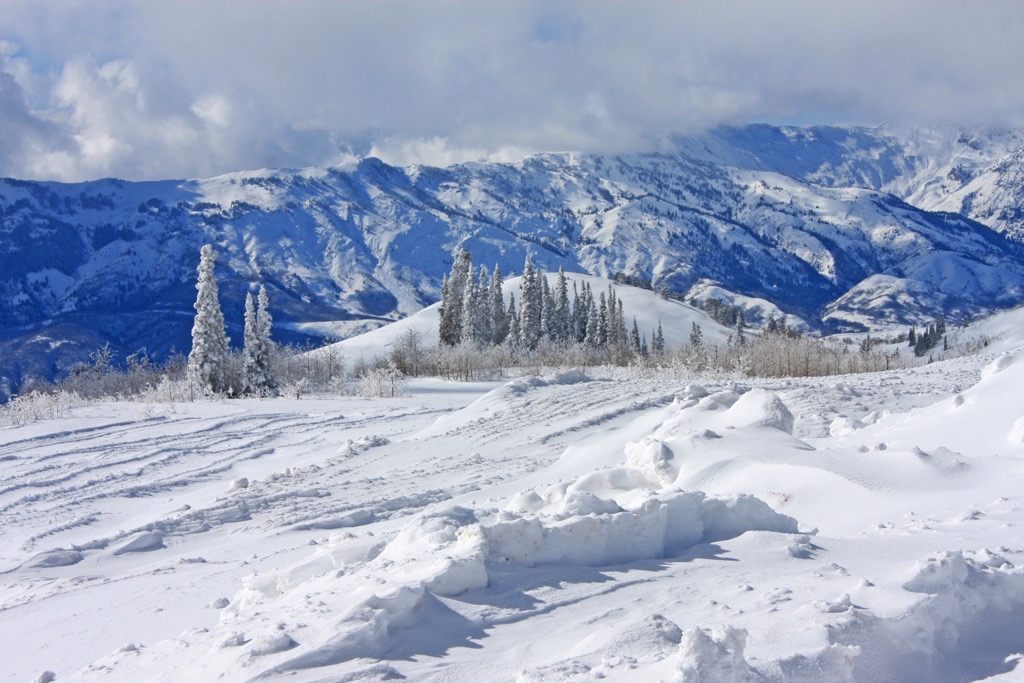
A long, winding traverse connects the Timberline Lift's top to the Sundown Lift's base. Sundown is a perfect jumping-off point for beginner and intermediate skiers who want to start skiing off-piste. It’s a shorter drop than at the Hidden Lake Express or Paradise lifts, but there are still lots of good turns on this part of the mountain. There is also another terrain park off of Sundown Lift, which you can reach by turning left as you get off the chair.
This side of the mountain also runs down into Powder Country. After getting off the lift and heading skier’s left down Confidence, you’ll see an expanse of trees on your right-hand side. This terrain is Powder Country, where the name says it all. It’s a broad forest that runs over rolling terrain down to the road. If you decide to drop here, just know you’ll have to take a shuttle back to the resort village.
Woody's World is on the opposite side of the road from where Powder Country drops you off. Woody’s world is the mirror image of Powder Country, a broad swath of trees where powder caches await long after big storms. The shuttle ride to the top of Woody’s World (the back side of Hidden Lake Lodge) is a little longer, but the runs back down to the shuttle stop are much longer, too.
Lefty’s Canyon and Mary’s Bowl both feature a solid mix of terrain types for skiers of different ability levels. They both feature rounded bowls with short-but-sweet runs that cut through glades of aspen trees. It’s a good spot for people who want to learn to ski powder to start making turns off-piste.
Lefty’s and Mary’s are both centered around the Summit Village. If you stay at Summit Village, you could spend a whole day just orbiting your lodging in these two canyons.
Non-lift-accessible terrain is where things get complicated at Powder Mountain. More than half of the mountain’s in-bounds, avalanche-controlled terrain is not accessible by any lift. Instead, the resort provides access to these areas with guided snowcat and snowmobile tours or ski touring.
It’s not quite backcountry skiing, but it’s also not quite resort skiing. The terrain is all avalanche controlled, so it’s much safer than actual backcountry skiing. And, depending on which option you choose, you won’t have to hike up before skiing back down.
These tours are a great way to ski fresh, untouched Utah powder. However, be aware that cat rides, snowmobile tours, and guided backcountry skiing all come at a premium above the cost of a day/season pass. The bottom half of Coyabe Canyon, all of Lightning Ridge, and half of Sundown face are only accessible by snow cat. Cat rides cost an additional $25 on top of a day or season pass.
Lefty’s Canyon’s lower half is inaccessible without a guided tour. Snowcats don’t service this area, and it’s only accessible through the Ski n’ Skin Guided Experience. This option is $400 but includes the cost of a day ticket. You can also access Lightning Ridge via Ski n’ Skin.
Other options for out-of-bounds skiing at Powder Mountain include snowmobile tours, ski tours, and cat skiing. Snowcats and snowmobiles service the south face beyond resort boundaries, including Mary’s, Davenport, and Gertsen. The area you can access with a guide beyond the resort is massive. These areas are barely included on the map and cover thousands of acres.
You can explore one more region out-of-bounds with a guide, namely the north aspect beyond the resort's boundary. DMI (Don’t Mention It) is a long, wide box canyon that descends from the top of James Peak. The DMI area is accessible only by ski touring and is some of the steepest and most technical terrain you can access around Powder Mountain.
You can also explore all these regions without a guide, but you will be hiking under your own power and will not have access to the snowcat or snowmobile transport. However, the price is right, and you won’t have to worry about group dynamics with a guide.
Powder Mountain’s ticketing page includes information for single and multiple-day tickets, season passes, lessons, backcountry guided adventures, and even bus passes for transit to the mountain.
Like most US resorts, it’s always wise to buy Powder Mountain tickets online ahead of time is always wise. Buying in advance, even one day, can save you $20-40, depending on your pass. Otherwise, a full-price adult day ticket costs $159. You can also buy a 5-pack of passes at a slight per-day discount.
The most considerable discount that Powder Mountain offers is for military personnel. Armed service members get a 35% discount on lift tickets. A military appreciation day is held twice annually when veterans and active duty military folks can ski for free. On these days, military dependents get 50% off day passes as well.
Tickets for night skiing are sold separately from day tickets. Night tickets are valid 3 PM-9 PM and cost $39 for adults. Night skiing is a great way to get some turns for cheap. Sometimes, after a day of heavy snow, the mountain will be full of powder when night skiing opens. Powder Mountain also offers college nights, with steep discounts for students.
Once spring rolls around, the deals start flying at PowMow. The spring 3-pack deal lets you get three-day passes for the late spring for $147, an absolute steal compared to regular season prices.
The most affordable way to see Powder Mountain is to buy an Indy Pass. This collective pass of resorts across America gives you access to each resort for a certain number of days each year. Prices range from $299-399, depending on which set of benefits you choose.
But if you want to see the whole resort, it will take at least an entire season. Getting a season pass at Powder Mountain is tricky. Sales for the next ski season usually start in March of the current year. It’s a big commitment, but Powder Mountain rewards diehard locals by offering a discount to people who buy early or have bought a season pass to the resort before.
Ultimately, when it comes to passes, full details vary depending on when you plan to be there and what you want to do while on the mountain. I recommend consulting Powder Mountain’s website for all the juiciest details.
There’s nothing better than staying in a ski-in-ski-out chalet. Powder Mountain has a lot of lodging options to suit all kinds of budgets, both on and off the mountain. There has been recent widespread construction at the mountain. Since 2018, brand-new vacation rentals have been available at every village on the resort.
The more high-end properties are usually found around Summit Village. Properties in this neighborhood range well over $1,000 per night but have stunning views, tons of space, saunas, and hot tubs.
The Hidden Lake Lodge area has the most options for various budgets. Most properties on AirBnB are either in this area or near Sundown Lift. Lower mountain properties range from $150 per night to around $1,000. However, regardless of the amenities, you’re guaranteed to be able to ski right back to your lodging at the end of the day.
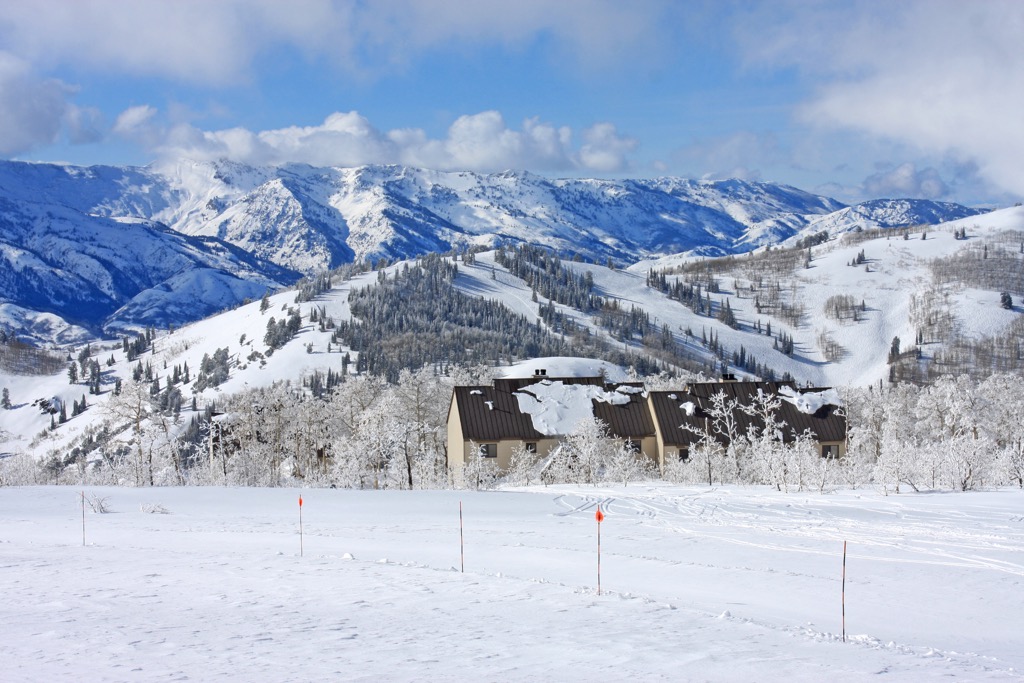
There are four lodges at Powder Mountain. Bower Lodge sits down the road from the resort in the town of Eden. Timberline Lodge is just to the skier’s left of Timberline Lift. Sundown Lodge is at the base of Sundown Lift. And finally, Hidden Lake Lodge sits at the top of it all.
Bower Lodge has a spiffy cafe, a woodfired pizza kitchen, and an excellent bar hosting après on Wednesdays and weekends. It’s down the canyon from the resort, but if your lodging is in or around Eden, it’s worth stopping by.
Timberline Lodge has a large-scale cafeteria with perfect options for when you’re on the go. It’s also home to the Powder Keg, a picture-perfect resort bar open 11 AM-6 PM daily. Powder Keg is one of the best ski bars in Utah and exactly where you want to be after a long day on the slopes. Timberline’s closest neighbor, Sundown Lodge, has quick and easy pizza by the slice from a local pizzeria.
Hidden Lake Lodge offers a slight change of pace with the Hidden Lake Cantina, a Mexican eatery with premium views of the surrounding resort. The vista has got to be one of the best panoramas in the Wasatch Mountains, and it’s a cozy spot to stop and warm your hands over lunch.
Powder Mountain’s event calendar always has something fun to do. The resort’s two bars, Bower Lodge and Timberline Lodge, have live music a few nights per week. Fridays are the big nights at the Powder Keg, with rotating local artists.
Other events like ski demos from boutique custom ski shops, slalom races, telemark races, ski movie screenings, and freestyle competitions are in constant rotation on the hill. You just have to watch the calendar and see what’s coming up.
The nearest major city to Powder Mountain is Ogden, located about an hour to the southwest. Ogden locals are big fans of two ski resorts. One is Powder Mountain, and the other is Snowbasin. Snowbasin is a 3,000-acre (1,214 hectare) resort that boasts the shortest drive time to Salt Lake International Airport of any ski resort in Utah. The terrain is very steep, and the mountain includes an impressive amount of vertical gain, covering more than 3,000 feet (914 m) from bottom to top. If you’re planning a ski trip to Powder Mountain and want to check out another nearby mountain, Snowbasin should be at the top of your list. Although they receive slightly less snow than resorts like Alta and Snowbird, the terrain and lack of crowds make Snowbasin your best bet.
